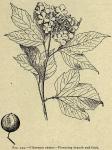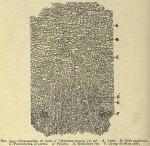 The dried bark of Vibur'num op'ulus Linné
The dried bark of Vibur'num op'ulus Linné
HABITAT.—North America.

 DESCRIPTION OF DRUG.—Very thin pieces or occasionally quills, outer surface, light gray, with purplish-brown stripes and very small brown lenticels; thicker pieces purplish-red, or occasionally blackish; odor strong and characteristic; taste bitter; the inner surface is yellowish or brownish; fracture short. The bark of the mountain maple (Acer Spicatum) was an adulterant formerly described by misled authorities, as Viburnum opulus.
DESCRIPTION OF DRUG.—Very thin pieces or occasionally quills, outer surface, light gray, with purplish-brown stripes and very small brown lenticels; thicker pieces purplish-red, or occasionally blackish; odor strong and characteristic; taste bitter; the inner surface is yellowish or brownish; fracture short. The bark of the mountain maple (Acer Spicatum) was an adulterant formerly described by misled authorities, as Viburnum opulus.
Powder.—Light brown. Characteristic elements: Parenchyma of inner cortex, with rosettes of calcium oxalate; middle bark bearing reddish-brown coloring matter, starch (5 to 12 µ in diam.); tracheal fragments with lignified wood fibers; few stone cells; crystals of calcium oxalate, few aggregate (15 to 30 µ in diam.); polygonal cork cells, thin-walled.
ACTION AND USES.—Claimed to be antispasmodic, hence the name cramp bark. Dose: 30 gr. to 2 dr. (2 to 8 Gm.).

